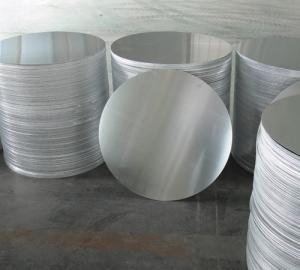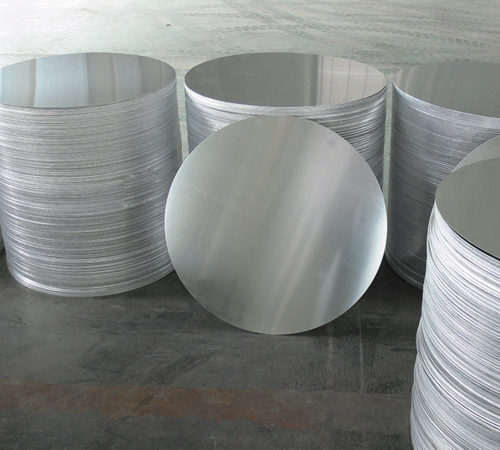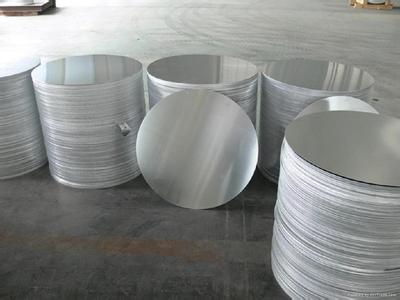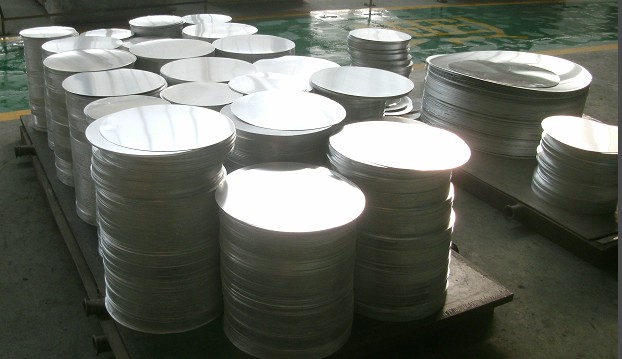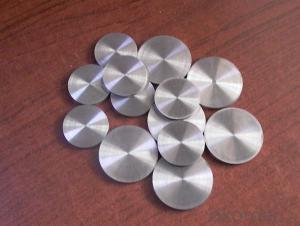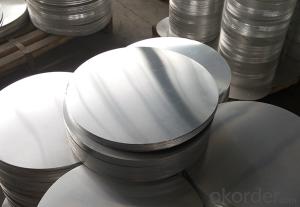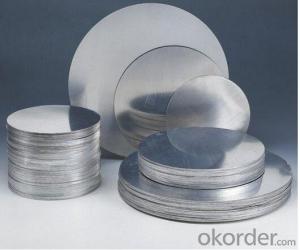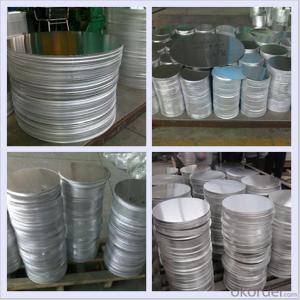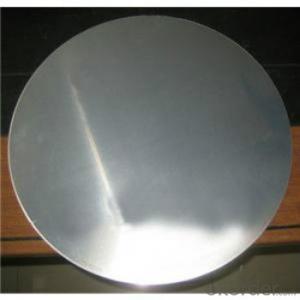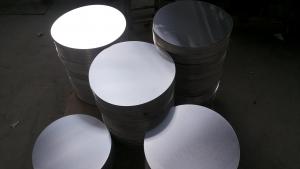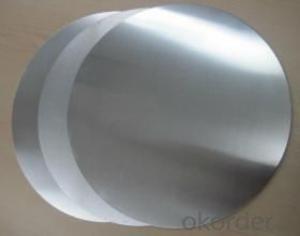High Quality Aluminum Circle
- Loading Port:
- China Main Port
- Payment Terms:
- TT or LC
- Min Order Qty:
- -
- Supply Capability:
- -
OKorder Service Pledge
OKorder Financial Service
You Might Also Like
1.Structure of Aluminum Circle
Aluminium circle can be used in the different ways, such as the pot and the decoration. The aluminium for pots can be prepainted and non-prepainted; With Teflon for non-stick pot.
And for the different techinique, we have the DC and CC disque, DC is suitable for the deep drawing, and the pot can be more than 20cm; And for the CC disque is suitable for the Spinning, and the hight can be more than 10cm;
2.Main Features of the Aluminum Circle
1) Dimensions can be produced according to clients' specifications
2) Good plasticity, conductivity
3) Generally used in industrial and construction applications
4) Scrap rate: less than 3%
3. Aluminium Circle Images:
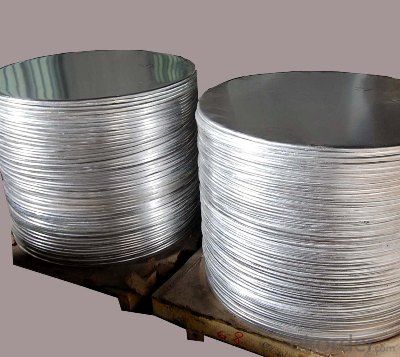
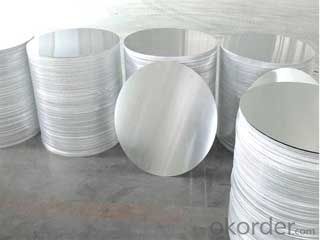
4. Aluminium Circle specification:
1) Alloy: 1050, 1060, 1070, 1100, 1200, 3003, 3004, 3105 , 5005, 5052, 6061, 8011
2) Temper: O, H12, H14, H16, H18, H22, H24, H26, H32
3) Thickness: 0.30-4.00mm
4) Diameter: 100-980mm
5. FAQ
We have organized several common questions for our clients,may help you sincerely:
①How about your company?
A world class manufacturer & supplier of castings forging in carbon steel and alloy steel,is one of the large-scale professional investment casting production bases in China,consisting of both casting foundry forging and machining factory. Annually more than 8000 tons Precision casting and forging parts are exported to markets in Europe,America and Japan. OEM casting and forging service available according to customer’s requirements.
②How to guarantee the quality of the products?
We have established the international advanced quality management system,every link from raw material to final product we have strict quality test;We resolutely put an end to unqualified products flowing into the market. At the same time, we will provide necessary follow-up service assurance.
③How long can we receive the product after purchase?
In the purchase of product within three working days, We will arrange the factory delivery as soon as possible. The pecific time of receiving is related to the state and position of customers.Commonly 7 to 10 working days can be served.
- Q: This question asks about the chemical reactions of aluminum with acids and alkalis under various conditions.
- <p>Aluminum reacts differently with acids and alkalis depending on the specific environment. In the presence of acids, such as hydrochloric or sulfuric acid, aluminum undergoes a redox reaction where it loses electrons and forms aluminum ions (Al^3+). The reaction can be represented as: 2Al + 6HCl 鈫?2AlCl鈧?+ 3H鈧? With alkalis, aluminum reacts to form aluminate ions and hydrogen gas. This reaction is represented as: 2Al + 2NaOH + 6H鈧侽 鈫?2NaAl(OH)鈧?+ 3H鈧? The rate of these reactions can be influenced by factors such as temperature, concentration, and the presence of catalysts.</p>
- Q: This question asks for typical applications of aluminum in various industries and everyday life.
- <p>Aluminum has a wide range of common uses due to its lightweight, corrosion resistance, and high strength-to-weight ratio. It's extensively used in the manufacturing of transportation vehicles like cars, airplanes, and bicycles for its strength and low weight. In construction, aluminum is used for window frames, roofing, and facades. It's also prevalent in food and beverage packaging due to its excellent barrier properties. Other uses include electrical wiring, electronics, and everyday items like pots and pans. Additionally, aluminum is used in the production of various alloys to enhance the properties of other metals.</p>
- Q: Is aluminum a suitable material for use in the electronics manufacturing industry?
- <p>Yes, aluminum is widely used in electronics manufacturing due to its excellent electrical conductivity, lightweight nature, and resistance to corrosion. It is commonly used in various electronic components such as heat sinks, capacitors, and wiring. Aluminum's malleability also allows it to be easily shaped into different forms, making it versatile for manufacturing purposes. Additionally, it is cost-effective and abundant, which further contributes to its popularity in the electronics industry.</p>
- Q: Is it possible to recycle aluminum and what are the benefits of doing so?
- <p>Yes, aluminum can be recycled, and it is one of the most recycled materials in the world. Recycling aluminum saves up to 95% of the energy needed to produce new aluminum from raw materials. It also reduces greenhouse gas emissions and conserves natural resources. Recycled aluminum can be used in various applications, from beverage cans to construction materials, making it an environmentally friendly and economical choice.</p>
- Q: Is it possible to recycle aluminum in countries other than one's own?
- <p>Yes, aluminum can be recycled in many countries around the world. Recycling aluminum is a global practice due to its economic and environmental benefits. The process involves melting down old aluminum products, which requires significantly less energy compared to producing aluminum from raw materials. This makes aluminum one of the most recycled materials globally, with a well-established recycling infrastructure in various countries. The recycled aluminum is used to manufacture new products, reducing waste and conserving resources.</p>
- Q: This question asks about the potential dangers associated with exposure to aluminum through consumption of food and drinking water.
- <p>Aluminum exposure in food and water can pose several health risks. Chronic exposure may lead to cognitive dysfunction and Alzheimer's disease, although this link is still debated. It can also cause bone disease by leaching calcium, potentially leading to osteomalacia and osteoporosis. In the nervous system, aluminum can cause neurotoxicity, leading to symptoms like memory loss and impaired learning. Additionally, aluminum may accumulate in the brain, potentially contributing to neurodegenerative conditions. It's important to note that the extent of these risks can vary based on individual susceptibility and the level of exposure.</p>
- Q: This question asks about the impact of aluminum on human health when it is consumed through food packaging.
- <p>Aluminum is commonly used in food packaging due to its lightweight and durability. However, concerns have been raised about its potential health effects. Aluminum can leach into food, especially in acidic conditions, and be ingested by humans. While the body naturally excretes some aluminum, excessive intake may lead to accumulation, particularly in the brain, bones, and kidneys. Long-term exposure has been linked to neurological disorders, including Alzheimer's disease, and may contribute to bone diseases. However, the scientific consensus is not definitive, and more research is needed to establish a clear causal link. It's important to note that the risk is generally considered low for most people, but it's advisable to minimize exposure, especially for vulnerable populations like infants and those with kidney issues.</p>
- Q: This question asks to outline the various environmental effects that result from the production of aluminum.
- <p>Aluminum production has several environmental impacts. It is energy-intensive, leading to high greenhouse gas emissions, primarily CO2, contributing to climate change. The process also generates toxic byproducts such as fluorides and cyanides, which can contaminate soil and water. Biodiversity is affected due to habitat destruction from mining activities. Additionally, aluminum production consumes significant amounts of water, which can strain local water resources. The industry also contributes to air pollution through the release of particulate matter and other pollutants. Overall, aluminum production poses a significant environmental challenge that requires sustainable practices and technologies to mitigate its impacts.</p>
- Q: This question inquires about the potential differences in cooking performance when using various types of aluminum foil.
- <p>Yes, there are differences in cooking performance between different types of aluminum foil. The thickness of the foil can affect heat distribution and cooking time; heavier gauges are more durable and better for roasting and baking, while thinner foils are suitable for lining pans or wrapping foods. The quality of the foil, such as whether it's non-stick or not, can impact food release and cleanup. Additionally, some aluminum foils are designed to be heat resistant up to higher temperatures, making them suitable for broiling or grilling, while others may not withstand such high heat. It's important to use the appropriate type of aluminum foil for the specific cooking method to ensure food safety and optimal results.</p>
- Q: This question asks about the various applications and purposes of aluminum in different industries and everyday life.
- <p>Aluminum is widely used due to its lightweight, corrosion resistance, and high thermal and electrical conductivity. It's extensively used in the transportation industry for manufacturing vehicles, airplanes, and ships. In construction, it's used for window frames, roofing, and structural components. Aluminum is also prevalent in packaging, particularly for food and beverages, and in electrical components like wiring and capacitors. Additionally, it's used in everyday items such as cans, foil, and cookware, and in industrial machinery and tools. Its versatility and recyclability make it a valuable material across many sectors.</p>
Send your message to us
High Quality Aluminum Circle
- Loading Port:
- China Main Port
- Payment Terms:
- TT or LC
- Min Order Qty:
- -
- Supply Capability:
- -
OKorder Service Pledge
OKorder Financial Service
Similar products
Hot products
Hot Searches
Related keywords
